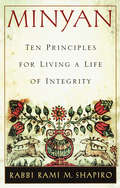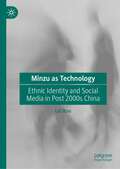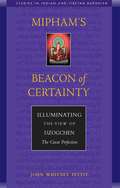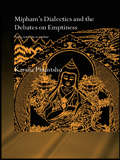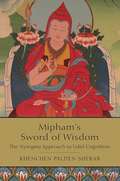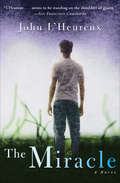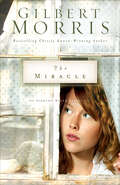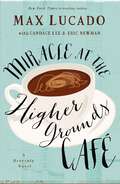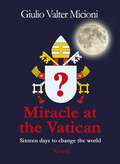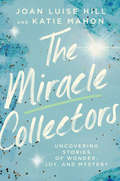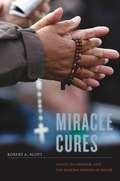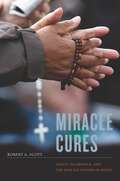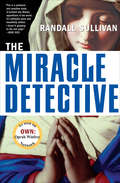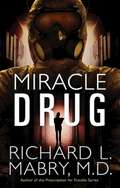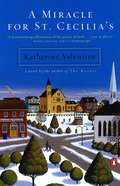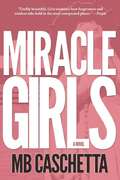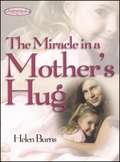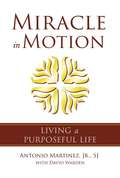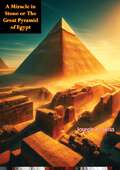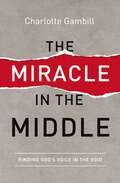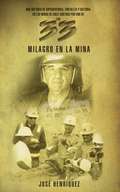- Table View
- List View
Minyan: Ten Principles for Living a Life of Integrity
by Rami M. ShapiroA path of daily living based on ten spiritual practices that have been used by Jews for centuries. MINYAN is an invaluable source of inspiration and insight not only for those large numbers who are returning to Judaism but for people of all faiths who are looking for a way to integrate spirituality into their daily lives.
Minzu as Technology: Ethnic Identity and Social Media in Post 2000s China
by Lei HaoThis book provides a unique ethnographic approach to the understanding of ethnogenesis in the Chinese context, with a particular focus on how it is being reshaped in the post-2000s era. It reinterprets the Chinese concept of ethnicity, or minzu, by investigating its evolution in relation to the proliferation of media technologies. In an era characterized by digital connectivity, the quest for ethnic identity has taken on new dimensions. Ethnic groups, like the Sibe community from Xinjiang, are now extending beyond the state’s traditional interpretations of minzu. Leveraging the power of media technology, they are articulating and expressing their ethnic identities in new and personalised ways. These developments have led to the emergence of what this book terms ‘networked ethnicity,’ a fresh manifestation of ethnic identity formation in the era of social media. The pivotal question this book attempts to answer is: How does an ethnic group in China today understand its identity, and what role does technology and media play in that process? This exploration offers a critical perspective on the complex interplay between digital technology, individual agency, and ethnic identity formation. This study will be of interest to scholars of cultural studies, Chinese society, ethnic studies, and media studies, or anyone keen to understand the changing landscape of ethnic identity in the digital age.
Mio Libreria Cristiana: Una collezione classica
by Bernard LevineMio Libreria Cristiana di Bernard Levine Una collezione classica TRE LIBRI IN UNO Quando si prega Dio manda gli angeli Cosa fareste se vedeste Gesù Avete sentito che ci saranno dei premi in paradiso?
Mipham's Beacon of Certainty
by John W. Pettit Penor RinpocheFor centuries, Dzogchen - a special meditative practice to achieve spontaneous enlightenment - has been misinterpreted by both critics and malinformed meditators as being purely mystical and anti-rational. In the grand spirit of Buddhist debate, 19th century Buddhist philosopher Mipham wrote Beacon of Certainty, a compelling defense of Dzogchen philosophy that employs the very logic it was criticized as lacking. Through lucid and accessible textural translation and penetrating analysis, Pettit presents Mipham as one of Tibet's greatest thinkers.
Mipham's Dialectics and the Debates on Emptiness: To Be, Not to Be or Neither
by Karma PhuntshoThis is an introduction to the Buddhist philosophy of Emptiness which explores a number of themes in connection with the concept of Emptiness, a highly technical but very central notion in Indo-Tibetan Buddhism. It examines the critique by the leading Nyingma school philosopher Mipham (1846-1912) formulated in his diverse writings. The book focuses on related issues such as what is negated by the doctrine of emptiness, the nature of ultimate reality, and the difference between 'extrinsic' and 'intrinsic' emptiness. Karma Phuntsho's book aptly undertakes a thematic and selective discussion of these debates and Mipham's qualms about the Gelukpa understanding of Emptiness in a mixture of narrative and analytic style.
Mipham's Sword of Wisdom
by Khenchen Palden SherabPresents the Nyingma-lineage understanding of valid cognition in Buddhism. Its core subject is the Buddhist view of the two truths—the relative truth of conventional appearances and the absolute truth of emptiness and buddha nature—and how the two truths are inseparable. The main questions posed are: How can we know the two truths and how can we be certain that our knowledge is accurate?“The great scholar and advanced spiritual master Jamgon Mipham’s Sword of Wisdom is a classic work that explicates valid cognition. I am happy to see it now available in English with commentary and scholarly appendices that will be very helpful for serious students in understanding this profound and important text.”—His Holiness the Sakya Trichen Mipham’s Sword of Wisdom explores the Nyingma-lineage understanding of valid cognition in Vajrayana Buddhism. This translation, a clear and concise primer on higher realization through valid cognition in Buddhist philosophy, presents these ideas in English for the very first time and includes the sutra presentation of the two truths and the tantra teachings of the two truths as the purity and equality of all phenomena. When you’ve finished Mipham’s Sword of Wisdom, you’ll have rich insights into Nyingma teachings on valid cognition, a profound new understanding of the two truths and their inseparability, a solid foundation in valid cognition through direct perception and reasoning according to the traditional Indian treatises of Dharmakirti and Dignaga, and much more.
The Miracle: A Novel (Books That Changed the World)
by John L'Heureux&“The author seems to be standing on the shoulders of giants . . . gives a rare human depth to a young priest who wants to become a saint&” (San Francisco Chronicle). In a pitch-perfect, deeply satisfying work of fiction selected as a New York Times Notable Book, a Publishers Weekly Best Book, and recipient of the Gold Medal for Fiction from the Commonwealth Club of California, master storyteller L&’Heureux enters the world of an unorthodox young priest whose faith is put to the test. Father Paul LeBlanc is young, handsome, and charismatic, but he has dangerous ideas on sex, marriage, and birth control—and he just doesn&’t uphold the decorum expected of a young priest. When, for no reason, a miracle occurs—a dead girl is brought back to life before his eyes—Father LeBlanc finds his faith, his vows, his reason, and his life itself called into question, leaving him with nowhere to turn. Witty, profound, and deeply moving, The Miracle explores the way God meddles in our lives and to what end. It is John L&’Heureux&’s best, most daring novel to date. &“Written in swift-moving prose of unaffected simplicity . . . It comes off as neither pat nor preachy but, rather, as a delicately nuanced portrait of recognizable human individuals making what they can of life.&” —The New York Times Book Review &“L&’Heureux brings the priest through his crisis of faith with the same tenderness that makes all his books such a pleasure in read.&” —TheLos Angeles Times Book Review &“L&’Heureux&’s snappy, succulent novel of faith and body, starts out sharp and ends with a razor slash.&” —The Baltimore Sun
The Miracle (Singing River Series #3)
by Gilbert MorrisRaising four strong-willed younger siblings after her mother&’s death and her father&’s imprisonment, seventeen-year-old Lanie Freeman never knows what new adventure will roll into view—such as her brother&’s wild idea to turn the family&’s old truck into a traveling store. The Freeman Rolling Emporium could provide the financial security Lanie and her family so desperately need, or it could tear them apart. Yet it&’s only a prelude to other changes. Author Brent Hayden&’s arrival in Fairhope breathes fresh life into Lanie&’s dream of becoming a writer. And then the hammer descends … Lanie&’s father is diagnosed with cancer, and the faith and unity of her family are stretched to the limit. And on top of this shattering news, a crisis is about to strike that will rock the whole town of Fairhope—and shatter Lanie&’s dreams of love. The Miracle continues the story of a young woman&’s valiant struggle to uphold her faith, her family, and her dreams during the height of the Great Depression.
Miracle à Coffeeville: And Other Legends Of Christmas
by Darrell CaseSi vous aimez la saison de Noël, l'ambiance festive, l'arbre, les cadeaux, les festins, les chants. Les gens semblent être plus gentils les uns avec les autres. On organise des réunions avec la famille et les amis. Cependant, il y a un danger. Nous pouvons être tellement absorbés par les fêtes que nous en oublions le vrai sens de Noël. Un recueil de contes de Noël qui vous aidera à retrouvrer la joie de cette saison des miracles.
Miracle at the Higher Grounds Cafe
by Max LucadoWhat if you could ask God anything? What would you ask? And how would he answer?Chelsea Chambers is on her own. After a public split from her NFL superstar husband, Chelsea takes a bold step out of the limelight and behind the counter of the Higher Grounds Café, an old-fashioned coffee shop in dire need of reinvention. But when her courage, expert planning, and out-of-this-world cupcakes fail to pay the bills, this newly single mom finds herself desperate for help. Better yet, a miracle.Then a curious stranger lands at Chelsea's door, and with him, an even more curious string of events. Soon, customers are flocking to the Higher Grounds Café, and not just for the cupcakes and cappuccino. They've come for the internet connection to the divine. Now the café has become the go-to place for people in search of answers to life's biggest questions.When a catastrophe strikes and her ex comes calling, Chelsea begins to wonder if the whole universe is conspiring against her quest to make it on her own. After a shocking discovery opens her eyes to the unseen world around her, Chelsea finds the courage to ask, and heaven answers in a most unexpected way.
Miracle at the Vatican: Sixteen days to save the world
by Giulio Valter MicioniThe novel unfolds over the sixteen days leading up to a future Easter close to our own times. By the end of these fateful days, the world will never be the same again. Given the onset of a series of uncontrollable worldwide crises - including social and religious conflicts - three Cardinals devise a plot that includes the Pope to restore peace among nations. The action unfolds in a crescendo of tension and twists and turns until it reaches the extraordinary final prodigious miracle. In these times of crisis, with Humanity seeking stronger certainties, this book may have a positive influence on the hearts and minds of people, inspiring them to renewed hope for a better future for Humanity. Recent world literature concerning the Vatican is increasingly oriented towards denigration and scandal, whereas this book presents a positive approach with a salvific vision that invites reflection in order to invigorate the spirit of the reader. Considering the universal interest of the themes dealt with, the novel could be of interest to readers all over the world, and be well suited for a film adaptation for international distribution.
The Miracle Collectors: Uncovering Stories of Wonder, Joy, and Mystery
by Joan Luise Hill Katie MahonThis eye-opening book will teach you how to step back, examine important moments in your life, and recognize the miracles that are constantly occurring all around you. As part of their own spiritual quest, miracle experts, Katie Mahon and Joan Luise Hill, discovered that when we are truly awake and present, miracles abound. It started by sharing their own stories which quickly prompted an unexpected outpouring of stories from others. Stories that had never been told, stories that didn't seem to matter, and stories that had been forgotten. While some defy explanation, others invite us to take a closer look, to discover common ground with each other, and to seek meaning in a whole new way. The stories of courage, forgiveness, gratitude, faith, hope, and love from The Miracle Collectors, allow us to notice and appreciate the miracles that are available to each one of us, while opening us up to a part of the Divine mystery we can absorb and understand. By using Take a Miracle Moment challenge at the end of every chapter you open the path for your own reawakening of the spirit. Perhaps you too will become a miracle collector.
Miracle Cures: Saints, Pilgrimage, and the Healing Powers of Belief
by Robert A. ScottIconic images of medieval pilgrims, such as Chaucer's making their laborious way to Canterbury, conjure a distant time when faith was the only refuge of the ill and infirm, and thousands traveled great distances to pray for healing.
Miracle Cures: Saints, Pilgrimage, and the Healing Powers of Belief
by Robert A. ScottIconic images of medieval pilgrims, such as Chaucer’s making their laborious way to Canterbury, conjure a distant time when faith was the only refuge of the ill and infirm, and thousands traveled great distances to pray for healing. Why, then, in an age of advanced biotechnology and medicine, do millions still go on pilgrimages? Why do journeys to important religious shrines—such as Lourdes, Compostela, Fátima, and Medjugorje—constitute a major industry? In Miracle Cures, Robert A. Scott explores these provocative questions and finds that pilgrimage continues to offer answers for many. Its benefits can range from a demonstrable improvement in health to complete recovery. Using research in biomedical and behavioral science, Scott examines accounts of miracle cures at medieval, early modern, and contemporary shrines. He inquires into the power of relics, apparitions, and the transformative nature of sacred journeying and shines new light on the roles belief, hope, and emotion can play in healing.
The Miracle Detective: An Investigative Reporter Sets Out To Examine How The Catholic Church Investigates Holy Visions And Discovers His Own Faith
by Randall SullivanThe Rolling Stone reporter&’s &“fascinating . . . globe-trotting, first-person spiritual odyssey&” into the Catholic Church&’s investigations of reported miracles (Seattle Post-Intelligencer). In a tiny, dilapidated trailer in northeastern Oregon, a young woman saw a vision of the Virgin Mary in an ordinary landscape painting hanging on her bedroom wall. After some skepticism from the local parish, the matter was placed &“under investigation&” by the Catholic diocese. Investigative journalist and Rolling Stone contributor Randall Sullivan wanted to know how, exactly, one might conduct an official inquiry into such an incident. So began his eight year immersion into the world of &“Miracle Detectives.&” Sullivan set off to interview theologians, historians, and postulators from the Sacred Congregation of the Causes for Saints, men charged by the Vatican with testing the miraculous and judging the holy. Sullivan traveled from the Vatican to the village of Medjugorje, in Bosnia-Herzegovina, where six visionaries had seen apparitions of the Virgin Mary. Then, on a more personal turn, he traveled to Scottsdale, Arizona, to visit the site of America&’s most controversial Virgin Mary sighting. In prose that &“often reads like a spiritual whodunit,&” The Miracle Detective takes you along Sullivan&’s eight-year investigation into apocalyptic prophesies, claims of revelation, and the search for a genuine, direct encounter between man and god (Publishers Weekly, starred review).
Miracle Drug
by Richard L. MabryThe infection wasn't supposed to happen, but it did. The treatment was supposed to take care of it, but it didn't. Then Dr. Josh Pearson discovers why--his patients, including the former President of the United States, have been dosed with a different strain of the original virus, one that is universally fatal. The only chance for survival is treatment with an experimental drug, but the manufacturer might already have discarded its supply. As if treating the President of the United States isn't stressful enough, the situation goes from bad to worse when Rachel Moore, a nurse Josh is falling in love with, falls ill. With the nation's eyes on him, Josh must pull off a miracle to save a man who holds a good deal of power and the woman who holds his heart.
A Miracle for St. Cecilia's
by Katherine ValentineIn the New England town of Dorsetville, the citizens are poor in worldly goods but rich in faith and compassion. For generations-long before the last woolen mill closed five years ago-Dorsetvillians have been bound together by the massive St. Cecilia's Catholic Church, slated to close after mass on Easter Sunday. On a bitter cold Ash Wednesday morning, Father James Flaherty despairs of ever turning the parish finances around. What will become of his flock and the beloved, ancient Father Keene, who had planned to live out his days at St. Cecilia's? Delightful and moving, with a cast of endearing and quirky characters, A Miracle for St. Cecilia's warms hearts and enchants readers everywhere.
Miracle Girls
by Mb CaschettaWhen Cee-Cee closes her eyes, she can suddenly see all the missing girls in the Mohawk Valley. It's part of the message: they are buried in wheat fields and stashed behind train tracks, or sprawled at the bottom of the canal. Could have been you, one dead girl says, smart-mouthed. But instead it was me! A live one tied up somewhere in a basement cocks her head: But, guess what--you're next!Cee-Cee tries to focus, but a terrible headache rises from the back of her neck, as if someone has struck her there. She should take her medicine, but Mrs. Patrick took away the pink bottles. In the thicket overhead, the branches are picked clean as bones, no longer swaying. Now she steps back until her heels butt up against the fat oak tree. In the woods, everything is silent. Even the trees stand still.It's 1973 in the Mohawk Valley, and children are disappearing. Cee-Cee Bianco is visited by the Virgin Mary, but her brothers see a much darker vision. When the youngest Bianco falls into a coma after witnessing a brutal crime in the woods and Cee-Cee performs a miracle, she is guarded by war-protesting Sisters whose order is not the benign sanctuary it seems.MB Caschetta is the author of Lucy on the West Coast (Alyson), which Ms. Magazine called "a spectacular collection." Her essays have appeared in the New York Times, the Chronicle of Higher Education, and Body & Soul. She lives in Massachusetts.
Miracle in a Daddy's Hug Gift
by John BurnsIn a world where so many boys and girls grow up deprived of their father's love, we see the repercussions of this depravation in the individual lives of these children and in society as a whole. The Miracle in a Daddy's Hug has a two-fold meaning: It's about the child who is a miracle full of miracles, and it's about the miracle-producing power of a daddy wrapping his arms, words, and heart around his child. This easy to read and understand book shares seven components of the miracle in a daddy's hug: First it examines the miracle of the child and the dad. Then, it looks at the value of touch, words, time, love, and faith. This book helps parents understand their children, it provides vision and strategies for both moms and dads, and it builds confidence in every dad that he can raise miracles called children.
The Miracle in a Mother's Hug GIFT
by Helen BurnsFemale readers will readily embrace this gentle yet strong exploration of the power of motherhood. Helen Burns confides that "every prayer I prayed, every bedtime story I read, every tear I kissed away, every encouraging word I spoke, every promise I kept, every memory I made -- all of these things truly mattered." Written in what she refers to as the "reward stage" of motherhood -- when all the seeds she has sown are reaping harvest in the lives of her now-grown children -- she rejoices that she can "fully understand the why behind the what in everything we do as mothers." Any mother will be refreshed as she is reminded of the value of the everyday miracles that result from expressing affection, being truly present in conversations, and demonstrating commitment in small ways.
Miracle In Motion: Living A Purposeful Life
by Antonio Martinez David WardenRev. T. J. Martinez, SJ is dying of stomach cancer and this book discusses his life before and after he starts a college preparatory school in Texas. This book is beautifully written. It is written to his students at the school: Cristo Rey Jesuit school in Houston, Texas. The Cristo Rey schools were founded to assist the poor to have a good education as preparation for College. He encourages his students by giving them examples from his own life. Not only does he encourage the students but he encourages his readers as well to find meaning, happiness, and most of all, God in their lives.
Miracle in Music City
by Natalie GrantIn this third title in the Faithgirlz Glimmer Girls series by Natalie Grant, Miracle in Music City, the Glimmer Girls are at it again—looking for a mystery to solve. Gloria wants her daughters to learn they aren’t too young to make a difference, so she gets them involved in her annual benefit and auction. But as things often do with the trio of smart and sassy sisters, they get themselves and their nanny Miss Julia involved in a lot more than just helping mom raise money for a worthy and wonderful cause.
A Miracle in Stone or The Great Pyramid of Egypt
by Joseph A. SeissEmbark on a fascinating exploration of one of the world's most enigmatic structures with Joseph A. Seiss's A Miracle in Stone: Or, The Great Pyramid of Egypt. This compelling work delves into the mysteries and marvels of the Great Pyramid, offering readers an insightful and thought-provoking examination of its construction, purpose, and significance.Joseph A. Seiss, a respected scholar, brings his keen analytical mind to bear on the ancient wonder of the Great Pyramid. In A Miracle in Stone, Seiss meticulously investigates the architectural precision and astronomical alignments of the pyramid, proposing that it is not merely a tomb, but a monumental embodiment of divine wisdom and ancient knowledge.The book presents a comprehensive analysis of the pyramid’s dimensions, geometric proportions, and symbolic meanings, exploring how these elements reflect profound scientific and spiritual truths. Seiss delves into the historical context of the pyramid’s construction, examining the theories about its builders and the advanced technological capabilities required to erect such a colossal structure.A Miracle in Stone, also explores the pyramid's potential connections to biblical prophecy and its significance within the context of ancient and modern religious thought. Seiss's narrative weaves together archaeology, theology, and mythology, providing readers with a rich tapestry of insights into the enduring mystery of the Great Pyramid.Join Joseph A. Seiss on a journey through the ages as he uncovers the secrets of the Great Pyramid of Egypt, revealing its significance as a miracle in stone and a testament to the ingenuity and spiritual vision of its creators. A Miracle in Stone: Or, The Great Pyramid of Egypt is a timeless exploration of one of humanity's greatest architectural achievements and its profound implications for our understanding of history and spirituality.
The Miracle in the Middle: Finding God's Voice in the Void
by Charlotte GambillFind strength in the struggle, passion to persist, wisdom when you're weary, and joy for the journey. If you've ever been on a long trip with small children you've no doubt heard, "Are we there yet?" Maybe you've even said those exact words or felt that same way as you have journeyed with God. Midway is where these feelings of frustration and impatience are most commonly felt. It's also where our hidden doubts find their voice. Where most beginnings start with energy and expectation for all that is ahead, and endings bring the joy of completion as you arrive at your desired destination, the middle is very different. This midpoint can too quickly become a low point, as energy is lacking and enthusiasm wanes. Yet how well you handle the middle reveals what is in the middle of you. The disciples found--in the middle of a lake--a revelation of Jesus that they had never seen on the shore. In the middle is where new navigational skills are found. It's also where some of the most significant lessons are learned. Join Charlotte Gambill in this compelling, story-driven message that shows through biblical teaching and life application how those who persist through the middle will find that miracles await them on the other side.
Miracle in the Mine: One Man's Story of Strength and Survival in the Chilean Mines
by José HenriquezOn October 13, 2010, millions of television viewers on five continents literally stopped everything to watch the amazing rescue of 33 men trapped underground in the mine of San José de Copiapó in northern Chile. What had seemed at first a hopeless tragedy later became a triumph of human effort, courage, perseverance, and expertise. For 17 excruciating days no one knew whether any of the miners had survived the collapse of the mine shaft, nor were the surviving miners aware of any rescue attempts. They spent a total of 69 days trapped underground. And it was there, in that frightening cavern, that one man took on the responsibility of encouraging the others and use the tragedy as an opportunity to share his faith. Miracle in the Mine is the story of José Henríquez. The testimony of a man who was no stranger to danger even before he found himself trapped 2,300 feet under the earth in the San José mine. A man who has unequivocally demonstrated his integrity, courage, and moral strength both before, during, and after the mining accident, and who is now using this experience to inspire the world.
